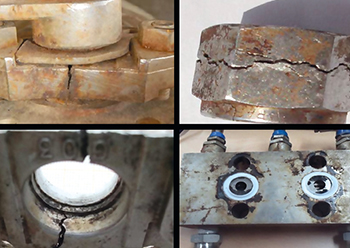Insight into corrosion cracking in pipelines
Germany-based AS-Schneider, a leading manufacturer of instrumentation valves, manifolds and double block and bleed valves worldwide, elaborates on chloride-induced stress corrosion cracking (CISCC) and what materials can be used to prevent it.
01 August 2020
Chloride-induced stress corrosion cracking (CISCC) is one of the most common reasons for steel deterioration. It attacks austenitic stainless steel components in the petrochemical industry.
Austenitic stainless steels are iron-based alloys that contain 19 per cent chromium and nine per cent nickel. These steels have high corrosion resistance in most aqueous and atmospheric settings. This resistance is due to passivation by a thin layer of chromium oxide. Humid and wet environments containing chloride ions can cause pitting as well as crevice corrosion of austenitic stainless steel components.
Corrosion can be catastrophic as it has the potential to discharge toxic substances and stored energy.
Many companies use 300-series stainless steel as it offers excellent resistance to general corrosion. Yet, even 300 series stainless steel is susceptible to CISCC.
Chloride corrosion of stainless steel
Stainless steel can donate free chlorine ions to an aqueous solution. Thus, it has the potential for causing failure in stainless steel. Chloride-induced corrosion is not like the bulk corrosion seen in rust. It is the exact opposite and does not spread out in an even layer like rust. Instead, pits and crevices form and grow perpendicular to the surface under attack. The corrosion is often severe in some areas although others may appear untouched.
Also, thicker pipes and tubes do not always last longer than thin ones; they are as susceptible to failure due to chloride-induced corrosion.
Chloride stress corrosion cracking is also known as SCC. A pipeline’s defence against it depends on the family of stainless steel from which it comes. The austenitic family is more vulnerable than any other.
Its resistance relates to the amount of nickel contained in the steel. Most vulnerable austenitic categories have nickel contents ranging from 8 to 10 weight per cent (wt%). Austenitic classes with high molybdenum and nickel contents such as 904L and alloy 20 have better chloride SCC resistance. Ferritic stainless steels are very resistant to chloride SCC. These steels include Types 430 and 444.
What is SCC in pipelines
Pitting is what causes the failure of stainless steel because of perforation. It engenders SCC in pipelines and other applications and reduces the life cycle of the stainless alloy. We assume that corrosion happens in several pits on both sides of the rivet deeps and also believe that it causes many fatigue cracks.
A system failure can occur because of the linkage between any two neighbouring cracks. The pits continue to grow until the pipeline ends up with fatigue crack nucleation. It is here that mechanical effects such as stress intensity factor come into play.
CISCC requires the presence of:
• Chloride: Saline environments cause CISCC in 300 series stainless steel;
• High temperature: Surface temperature of more than 40 to 60 deg C is enough to develop CISCC in 300 series stainless steel; and
• Stress – Applied or residual.
How does stress affect corrosion?
While there is no unified mechanism for SCC, experts have proposed various models, including the following:
• Film rupture model: Stress causes the local rupture of the passive film and sets up an active-passive cell;
• Absorption model: Specific chemical types absorb on the cracked surface and lower the fracture stress;
• Embrittlement model: Hydrogen embrittlement is a significant mechanism of SCC for steels and other alloys;
• Pre-existing active path model: This model uses pre-existing paths, such as grain boundaries. Under this model, one can see the formation of inter-metallics and compounds.
How to detect SCC
Dye penetrant testing is one of the tools used to detect SCC. It is the most straightforward and effective non-destructive examination technique. Eddy current testing is also useful. This type of testing uses purpose-designed probes calibrated on known defects.
While penetrant testing does not show the crack size, technicians may see it if they use eddy current testing. Technicians can also apply ultrasonic flaw detection as an automated or manual non-destructive evaluation (NDE) technique for detecting CISCC.
How to prevent SCC
One solution is the selection of the right material and the right sealing elements. Some of the materials that fight CISCC are alloy C-276 and 6Mo. It is common practice to use alloys for wetted/pressure-retaining parts and for small components in 300 series stainless steel.
However, this practice is not advisable as the tiny components lodge between other parts and can corrode and crack. Painting the system with aluminium is also recommended to fight CISCC.
Companies can also reduce the risk of SCC through equipment and plant design.
- Geberit HDPE tackles challenges
- Weicon launches emergency repair kit
- Grooved couplings, the ‘future for the industry’
- Insight into corrosion cracking in pipelines



